LATEST MACHINES OF MODERN WARFARE
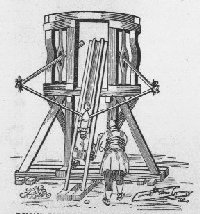 | | Roman Catapult for throwing stones |
Two great wars of recent date, the one between the United States and Spain and that between the Boers and Great Britain, have served one purpose, if nothing else, that of showing how terrible can be the destruction of modern inventions of war. The stride made in a century in the development of war vessels, guns, explosives and methods of warfare has been marvelous. No longer do we hear of the frequent hand to hand conflict, of grappling chain and cutlass on war vessels, and the practical use of the bayonet. One would fain believe that with the awful examples set, universal peace, as proposed by the Czar of Russia several years ago, might not be mere illusion.
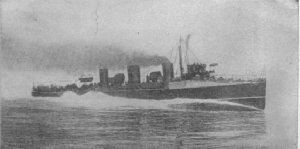 | "Velox," the fastest destroyer afloat.
Speed, 33.64 knots. |
In use for land forces some of the greatest improvements are the deadly machines, the rifle with great range, the high explosives, such as gun cotton, nitro-glycerine, smokeless powder, lyddite and cordite, mid the cruel "dum-dum" bullet. These inventions almost preclude anything save long distance firing and a rare gallant charge by the cavalry. On sea the changes have been even more marvelous. No longer do we see the old wooden hulls of vessels pierced by common round shot from the simple old cannon of smooth bore. Nowadays, electricity operates nearly everything on shipboard, from lighting of cabins and searchlights to the propelling of torpedo-boats and firing of mines, guns and other weapons. So nearly perfect had armor plate been devised against the assault of ordinary explosives and gun charges, and so thick were the coatings of heavy hardened steel, that new devices were necessary to pierce them, and pierce them they do, at great distances and with tremendous force.
LYDDITE.
The explosives of high power that serve for force to drive the monster projectiles from the throats of the gigantic cannons of to-day, are numerous and terrific. One of the principal new inventions is lyddite, an explosive of the same class as dynamite, cordite, maxinite, melinite, etc. Lyddite is a mixture of picric brought to a state of dense fusion.. This acid is given off by the action of nitric acid on carbolic acid. When a charge of this potent explosive goes off there is a deafening report, the outer coverings of the lyddite shells are ground into fine pieces and everything for a great distance around it is destroyed. This was used with deadly effect in the Boer, Japanese-Chinese and Soudan wars. During General Kitchener's campaign in the Soudan, a shell was dropped upon a temple of Mahdist worshippers and only twelve out of 120 there escaped alive. Cordite, discharged a twelve-inch shell into the Japanese flagship Matsushina during the Chinese conflict, hurled a large gun from its mounting, fired a quantity of ammunition, disabled two other guns, and killed and wounded ninety officers and men.
SMOKELESS POWDER
Smokeless powder has for its main principle the quality of exploding without giving off a smoke, save a slight violet vapor that is hardly noticeable. This powder is made in long cylindrical strings and cut up into little pieces. In order to keep this explosive oily and to prevent its igniting by friction from rough handling, it is shaken in a receptacle containing powdered black lead, or plumbago, thus receiving a coat of the stuff. Some kinds of smokeless powder resemble strips of slippery-elm bark. This
is made in slabs a foot or more in length, and about a quarter of an inch in thickness. This kind of powder is much more safely handled than ordinary black powder and will burn readily and without danger if a match is applied to it. The flame is steady and the powder does not flash off with a great splutter. Some of the stuff is cut up in chip shape. This will stand hammering, in fact, it is loaded into shells with a great deal of hammering. Cordite, as its name signifies, is made in long stringy shapes.
NITRO-GLYCERINE.
One of the best known of the terrible explosives is nitro-glycerine. This is used frequently for deadly purposes, but is more often used in commerce, for blasting rocks, wells, etc. In color, this explosive is generally a light yellow. It is odorless, has a sweet, pungent taste, and when placed on the skin will cause a headache. Its method of manufacture is somewhat as follows;
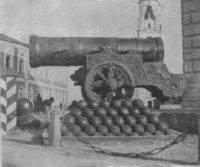 | One of the Napoleon's guns,
in the Kremlin, Moscow, Russia |
Into a large tank called an "agitator" is stirred a quantity of nitric and sulphuric acids, in equal quantities. The stirring is done by means of automatic, revolving paddles. After there are 25 pounds of the mixture, 1,500 pounds of sweet glycerine are added. At once the mixture rises rapidly in heat. Since it will explode at 90-degrees F, water pipes are provided about the agitator to keep the mixture cool. In carrying the stuff, there is great danger of spilling it, which would at once cause a terrible explosion. The life of the nitroglycerine maker is only about five years at his work. As in the factories of other powders and explosives, great care is taken that no metals are worn. The clothing and shoes of the employes must be changed frequently, so that gritting dust will not accumulate in them. Even canvas shoes must be worn, and the trousers of the working men must not, be turned up for fear gravel might be gathered in them.
THE "DUM-DUM" BULLET.
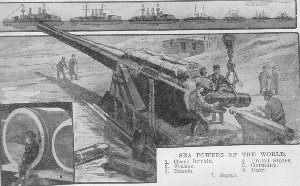 | Sea Powers of the world
| 1. Great Britain | | 4. United States | | 2. France | | 5. Germany | | 3. Russia | | 6. Italy | | 7. Japan | | |
|
Progress in the matter of projectiles has taken two distinct directions, one toward ferocity, the other, oddly enough, toward gentleness in warfare. The aim in battle generally is simply to disable the enemy. There is not a general desire to maim for life. Therefore, if a bullet cannot kill a man outright, it is better that it hurt him as little as possible. This is the effect of some of the better smooth balls fired from the modern small rifles. Men have even been known to be pierced by such bullets without serious injury. On the other hand, such affairs as the "dum-dum" bullet are atrocities for cruel intent. This bullet is driven by charges of cordite. The inner part of the bullet is made of soft lead, but it has a thin outer sheath of hard nickel or copper. Its end is cleft downward for a short distance. Thus, when this bullet strikes its victim, man or beast, the soft lead expands while the covering breaks
jaggedly, inflicting terribly painful wounds. Another monstrous invention is known as the base shell. This is a contrivance for firing from a big cannon, the ball having a base separate from the head. This base is on ball bearings and is equipped with four scythe-like knives which fold up on the side of the ball until it is discharged. When the shell starts on its errand of carnage, the rifling of the gun starts the pointed part of the shell to revolving, but the base stands stationary. The knives spring from their places and cover a diameter of 45 inches. It may be imagined what havoc these blades would work in a close line of infantry. And, even then, the work of the shell is not complete, for when it strikes it explodes. Other projectiles for naval warfare, weighing thousands of pounds, are made of hardened steel and will pierce the immense armor plates of the battleships with apparent ease. Most of these explode after striking.
TORPEDOES AND MINES.
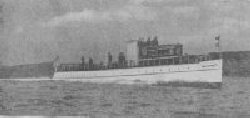 | Steam yacht "Arrow", fastest craft in the world.
Speed, 39.13 knots |
Torpedoes and mines are the dread of the navies of the world. The havoc they work is great and terrible. The former is built in the shape of a cigar, loaded with guncotton or dynamite in the point of the nose. Within the device is an electric storage battery attached to a propeller at the rear, which will drive the death-dealing machine boat through the water to the enemy's ship. When one of these torpedoes is to be discharged the electricity is turned on, the rudders adjusted so that the machine will go in a given direction, and then it is shot out of a compressed air device toward the enemy. It travels with little noise and great speed, and when it strikes an object its cap discharges its load of dynamite and wrecks everything witbin touch. During both peace and war important harbors are dotted over with submarine mines or bombs of great explosive force. These are connected with the shore by electricity so that they may be fired off at will many miles from the man who operates them. Some, also, float upon the surface and go off on contact. For those fired by electricity charts are made, showing the exact location of every one. By looking through a telescope the operator, miles away, can tell just when the enemy's vessel is over a certain mine. A switch is then turned, and the ship is blown to atoms.
THE GATLING AND HOTCHKISS GUNS.
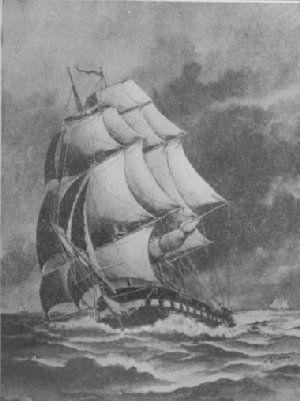 | Typical American warship of early times.
US Frigate "Constitution" ("Old Ironsides")
built in 1809, reeling off 13½ knots
an hour—a speed greater than that of the
racing yachts of today. |
The machine gun works deadly havoc either from the crow's nest or fighting top of a ship, or on the battlefield. Among the terrible engines of war those most prominent are the Gatling, Maxim and Hotchkiss guns. The first-named is constructed of a number of barrels joined together side by side so that at a distance the whole contrivance looks like a big, stubby gun. Generally about ten barrels make up one gun, and all revolve upon one central pivot. Each chamber has a separate lock which discharges the cartridge when the barrel reaches its proper position. The affair works by a crank and the cartridges are allowed to slide from a rack down through grooves into their chambers, and are ejected automatically as soon as discharged. About 1,200 shells a minute can be fired from a Gatling. The Maxim is entirely self-acting after the first discharge. The cartridges are loaded into the gun on a belt, and all the gunner has to do is to pull the trigger for the first shot, and keep aim. The recoil is sufficient to open the breech, throw out the empty shells, admit a fresh shell, cock the gun and fire it again. A belt with 600 cartridges, can run through the gun in a minute.
THE ARMSTRONG GUN.
The largest calibered rapid-fire gun is the Armstrong, which uses 4½ pounds of smokeless powder at a discharge, and throws a six-inch shell weighing 100 pounds with enough power to go through fifteen inches of wrought iron. Smaller guns of the same order throw forty-five pound shells at the rate of fifteen a minute. The Hotchkiss and Driggs-Schroeder rapidfire guns were invented by Americans and were designed principally for the fighting-tops of war vessels. They are swung on pivots, so that they may be thrown in any direction. This gun is fired shot by shot, but 36 shells a minute can be sent off with great force. The gunner steadies the gun by pressing a butt to his shoulder, like an ordinary fowling piece. He thus has his arms and hands free to aim the gun, load and fire it.
THE SEARCHLIGHT.
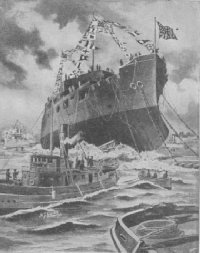 | Launching of the armored
cruiser "Colorado".
Illustration shows vessel leaving
"the ways" at Cramp's shipyard,
Philadelphia, April 25, 1903.
(Opposite picture represents her
completed and cruising at sea.) |
Of great use in modern warfare as well as in commercial marine service is the searchlight. Nowadays, nearly every steam-driven vessel is equipped with one or more of the great lights. In war they are serviceable in locating the enemy at night, in detecting the movement of torpedo boats, and in directing vessels by signals. In commerce they aid in signaling, in lighting the path of the vessel, and in rescuing people who fall overboard. They are used in lighthouses, and even fire departments in the great cities use them to light up dark buildings where the firemen must go. Some of these lights throw beams many miles. Generally they are made of lenses and reflectors that will collect and send out the light of a 25,000 candle-power electric arc lamp. They are constructed in cylindrical shape about a yard deep, and nearly of the same diameter. In the back are silver-back reflecting lenses of great power, and powerfu`l reflecting lenses are placed in the focus of the beam of the enclosed electric light. Both of these lenses collect and concentrate the light and throw it far out upon the night. The rays are kept so close together that nearly a mile away the width of the projected beam is only about fifty feet. The whole device is poised on a revolving pedestal and can be moved in any direction desired. One of the largest of these great searchlights was exhibited on the roof of the Manufacturers' Building at the World's Columbian Exposition at Chicago in 1893. It has since been installed in the observatory on the summit of Mount Lowe, California. It has a power of 3,000,000 candles, and throws a brilliant light 150 miles. Its huge reflecting lens weighs 800 pounds. This lens is three-quarters of an inch thick at the edges, and one-sixteenth in the center. The whole light weighs 6,000 pounds, is 11 feet high, and yet so delicately is it poised that a child can direct it at will.
MAKING OF ARMOR PLATE.
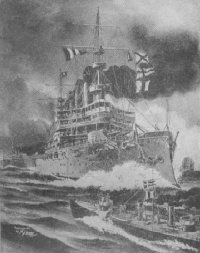 | The largest cruiser in active service.
USS "Colorado" at full speed.1 |
America makes by far the best armor plate in the world. The process of converting crude iron ore into the monster hundred-ton plates of steel, two feet thick, for the sides of battleships is very interesting. At South Bethlehem, Pennsylvania, is located the great modern plate-making plant. Here have been mastered so perfectly the great forces of nature that masses of metal so great as to seem almost immovable are handled with great simplicity. After the combination of pure iron and carbon which makes steel has been blasted free from impurities, and the metal has been shaped into glowing ingots, the open hearth system is resorted to, to shape the great hot masses into proper form. The reason for using an open hearth is on account of the great heat generated for making the armor plates. Sometimes pig iron is brought to the furnace and there mixed with scrap steel or other ingredients, to turn it into steel. No other enclosure for the steel is needed than the bare walls of the furnaces. Here the steel is subjected to about 4,000 degrees of heat. This intense heat is obtained by first treating coal with a great heat in airtight ovens, where there is but a limited supply of oxygen. This causes an intensely hot gas. This fiery gas passes through firebrick channels that open upon the hearth where the steel is waiting When the supply of fresh oxygen in the air meets this gas it bursts into flames instantly. The combustion is terrific and the iron and carbon or scrap steel are converted instantly into a flaming mass, while a heat of sunlike force is thrown off.
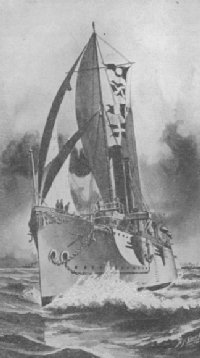 | | The US Cruiser "Galveston".2 |
The spare gas from this furnace is carried off through another firebrick passage, together with the hot air of the hearth. This passage opens upon another open hearth just opposite from the one in use. The spare heat thus keeps both warm, and in order to save the heat these passages are used reversely every twenty minutes, each keeping warm for the other, when its turn comes. This method saves a great expense. At South Bethlehem eight of these open-hearth furnaces are in use, four capable of handling forty tons of metal each, and the other four, half as much.
When the proper heat has been secured and the melting and mixing of the steel has gone far enough, the fiery liquid is run off from the hearths into great caldrons which run on rails. Thence the metal is ladled off into molds that also run on tracks. When the steel is poured into the molds there is no splashing, for the metal runs gently through a tube into the mold, which fills up bottom first. This process is called bottom filling and prevents bubbles and other inequalities in the steel when finished. Further precautions against impurities from gas, etc., are taken by having the inner lining of the molds made of a sort of steel lath-work covered with sand. Thus the gas escapes from the hardening steel without marring its grain. The hardening process differs from the old style method of hammering by which many flaws were occasioned. At the Bethlehem works "fluid compression" is used—that is, a great weight from hydraulic presses is put upon the steel while it is yet hot. Sometimes, this pressure equals 7,000 tons.
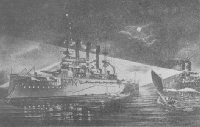 | The swiftest battleship afloat.
USS "Main".3 |
Great ingots from which guns and crankshafts for vessels are to be constructed often weigh 120 tons and take days to cool off. After they are cool enough to handle, great traveling cranes, with which the works are equipped, pick them up and transport them to other furnaces where they are heated over again in a temperature of over a thousand degrees Fahrenheit. These cranes are great heavy machines weighing about 175 tons, and needing 1,500-horse-power to operate them. In the reheating process, great care must be exerted not to crack the ingot. Then another pressure of about 28,000,000 pounds is brought to bear on the metal in a hydraulic shaping press. This method of tempering hardens the metal clear through, and not simply a few inches from the surface, as was the case with the hammering method. This is much better, for it gives the proper strength to withstand the great forces brought to bear upon armor plates, gun barrels and crankshafts. After several treatments of extreme heat and pressure, the tempering is finished by annealing, or by suddenly plunging into oil to prevent crystallizing.
After this hardening it might seem that the steel turned out would be so hard that it could not be altered in shape. Science, however, provides great shears, buzz saws and lathes which will turn the steel into desired shapes. The saws are 84 inches in diameter and are equipped with 76 inserted teeth. This saw can run through a steel plate 33 feet long and two feet thick. Lathes for turning guns and crankshafts for ships will turn great blanks and pare them as desired. Armor plates are shaped by being put under great hydraulic presses which exert tremendous power and will bend the plates to fit the ship for which they are intended.
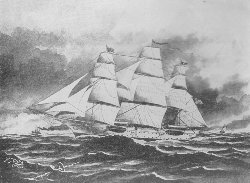 | A New Naval Nursery.
The USS "Chesapeake"
Her vaule to the US Naval Academy
proven, the Governement authorizes
three more of her class. |
These plates must undergo severe tests before they will be accepted for service in the navy. Government officers supervise all the work of casting and tempering to see that it is done right. These men select the seemingly poorest plates and test them. The testing is done on a special ground, and consists of firing heavy shells at the new armor from a short distance. Sometimes, the armor is only slightly scratched; again, the balls go through cleanly. If the testing plate stands the ordeal, the whole batch is accepted for the armor of some warship. If two plates fail all the casting is thrown out at the cost of the contractor, and a new set must be made. The best armor plates have been devised after plans by Harvey and by Krupp, the great gun makers. The surface of the plates is generally full of little odd seams and lines, but this does not mar the impenetrability of them.
SIX NEW BATTLESHIPS.
Since the Spanish-American war there have been great advances in the building of warships. Many new craft have been added to our navy. Six new monster battleships of the finest type have been provided: the Alabama, Kearsarge, Kentucky, Illinois, Maine and Wisconsin. The measurements of the Kentucky and Kearsarge will serve to indicate the size of our new naval equipment. The water-line length is 368 feet; displacement, 11,525 tons; horsepower, 10,000; speed, 16 knots an hour; water-line armor belt, 16½ inches; side armor above the belt, 6 inches; turret armor, 17 and 15 inches; conning tower, 10 inches protective deck, 2¾ inches. The armament consists of a main battery of four 13-inch guns, a secondary battery of fourteen 5-inch, rapid-fire guns, and twenty 6-pound rapid-fire guns. The submain battery has four 8-inch guns. The main battery projectiles weigh 1,100 pounds, leave the muzzle with almost incalculable energy, and have the penetrating power of piercing 34½ inches of wrought iron.
Experiments to disable a balloon in the air by rifle or field gun fire have been carried out by the Austrian army. A balloon 7,000 feet high was held at anchor, and the gunners, kept ignorant of the range, were told to disable it. Twenty-two shots were fired before the approximate range was found, and it was only at the sixty-fourth round that the balloon was hit, and that slightly, but the small rupture of the gas bag made it slowly descend.
1Description: Length, 502 feet; beam, 59 feet 6 inches; speed, 22 knots; horsepower, 23,000; battery, four 8-inch R. F. rifles, fourteen 6-inch, eighteen 14-pounders and twelve 3-pounders; cost, $3,780,000.
(Return to text).
2Only type of New Style Naval Vessel, with sails for motive power.
Class of six ships designed for "police protection" to the rapidly extending interests of this country.
Vessel is officially termed "an improved model of the 'Raleigh' class of cruisers," which were built when the craze for speed at any price was at its height, and is a "stayer" rather than a "flyer", having coal capacity to steam 12,000 miles. This, with her sail auxilliary power, renders her independent of many coaling stations and fits the ship for longer voyages than is possible with any other type of the new navy.
Description Speed, 16½ knots per hour; length, 308 feet; beam, 43 feet; displacement, 3,400 tons; battery, ten 5-inch, eight 6-pounders, two 1-pounders, and two Colt rapid-fire guns. Sail area, 6,000 square feet of canvas.
(Return to text).
3Namesake of the ship destroyed at Havanna, February 15, 1898, when 254 lives were lost in the service of the country.
The new vessel embodies all improvements suggested by experience in actual battles of the last ten years, and is the leading ship of her class in the navies of the world.
Description: Speed, 19.95 knots per hour; length, 288 feet; beam, 72 feet 5 inches; displacement, 12,500 tons; horsepower, 16,999; crew, 600; cost, $3,000,000; battery, four 12-inch rifles, sixteen 6-inch and twenty-four smaller guns, all of rapid fire.
Ship was launched at Philadelphia, July 27, 1901.
(Return to text).
A SLOT MACHINE THAT TAKES PHOTOGRAPHS
NEW WONDERS OF THE ELECTRICAL WORLD
Table of Contents
Return to Main Page
© 1998, 2002 by Lynn Waterman
|










